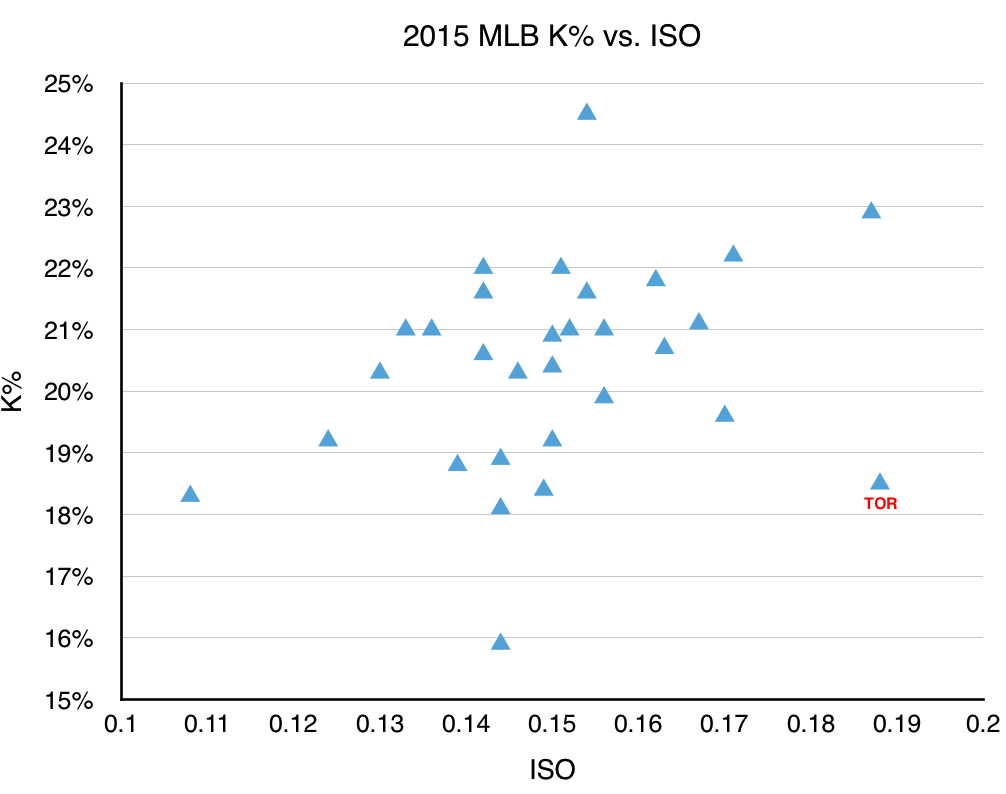With so much of the focus on baseball shifting to the statistical side in recent years, early season anomalies can get a lot of undeserved attention. Players can get lucky and can ride that luck to sky high batting averages or micro-ERA’s. However, eventually, as the sample grows, the good luck tends to balance out with some bad luck, and players return to their normal career trends for the remainder of the season.
Early on in 2016, we have seen some funky Blue Jays stats that would be very concerning if it were the middle of June, but because it’s just been a week, they probably aren’t so pressing. This doesn’t mean we should dismiss all stats from the first week of games because of the small sample size they occur have occurred in. Rather, if we’re going to dismiss them, we must look for a reason to do so such that we can chalk it up to a small sample and not a spike or drop in talent level. Here’s a couple of trends that have stuck out to me:
The Blue Jays are a “Strikeout Lineup” Now?
The Blue Jays set a record last week, albeit not in the way you and I would have liked. In the Rays series, they struck out the most that they ever have in a four game series, doing so 46 times, or 11.5 times per game. Against the Boston Red Sox over the weekend, the trend continued, as the team struck out 10 times in each of the first two games. Then, on Sunday, another five batters struck out.
At first glance, this doesn’t seem too out of the ordinary. Conventional baseball wisdom suggests that teams that hit lots of home runs, like the Blue Jays, sacrifice a bit in the contact department for the boost in the power department. Thus, the Blue Jays being 5th in the league in home runs while simultaneously striking out at the second highest rate in baseball at 27.4% is what we might call normal.
However, what makes the Blue Jays offense so special is that not only are they one of the most powerful lineups in baseball, but they do not give anything up in terms of contact to earn that distinction. For example, in 2015, the Blue Jays led Major League Baseball in home runs when they hit 232, and also had the 5th lowest K% at 18.5%. In the following chart, which charts K% and ISO, a measure of power, you can see what I mean (the best teams are in the bottom right).
In 2015, the Blue Jays rated out as the best team in this cross-comparison of statistics. Given that, there’s no reason to think that this strikeout-ful trend, at the beginning of 2016, will continue.
On an individual level, Josh Donaldson, who has struck out in 35.5% of his plate appearances in 2016, spoke to reporters on Sunday afternoon and actually gave a reason for his inflated strikeout numbers; he tried to expand that reason to some of his other teammates as well.
Donaldson, who has 4 home runs in the #BlueJays 7 games, says he's actually not too happy with his swing right now: pic.twitter.com/oO4OE4vcWU
— Arden Zwelling (@ArdenZwelling) April 10, 2016
Maybe he’s onto something, and the batters will start to make contact this week? Only time will tell.
Drew Storen’s Velocity is No Longer Elite?
One of the more impactful moves that the Blue Jays made this off-season was trading for Drew Storen in exchange for Ben Revere. This move allowed the team to move Aaron Sanchez to the rotation without being worried that the bullpen would lack depth, as Storen joined Roberto Osuna and Brett Cecil at the back of what on paper looked (and looks) like a formidable bullpen. However, we’re just days into the season, and there have already been many concerns that the bullpen isn’t good enough. Deservingly so or not, Storen has been at the forefront of the struggles.
Although he’s only pitched in three games, the concern about Storen is that he has lost a touch on his stuff. He’s found himself in trouble in two of the three games he’s appeared in; semi-blowing up against the Red Sox on Friday night, allowing two hits and two earned runs while retiring just one batter. Although the individual results don’t matter, how they happened does, and we can look at his velocity over the years to get a look at why people are worried.
His velocity thus far has been down across the board.Although, over the last few seasons, he’s started slowly in April, this year’s drop off is more drastic. He is averaging just 92.27 mph on his four seam fastball, way down from his April 2015 average of 94.66 MPH.
Another measure that we can look at is the movement he’s getting on his pitches. Below are two charts, the left being the horizontal movement he gets and the right being the vertical movement.
Here, we see a bit of a different picture. The movement he has gotten so far pretty much lines up with how he has done throughout his career.
Pitchers tend to ramp up their velocity as the season goes on, and Storen is no different than any others, but his drop off this season has been sharper than ever before. This could be due to age, and will be something to watch as the season progresses. If the velocity doesn’t recover like it should, Storen could continue to look hittable and struggle like he has this past week. It’s a small sample, but its a trend to watch.
Lead photo: Kim Klement-USA TODAY Sports




“Then, on Sunday, another five batters struck out.” I’m not sure what you mean by this. It’s definitely phrased as being more of a bad thing, which it was not at all. Also, you do realize that the average strikeout rate is just about one per inning now?